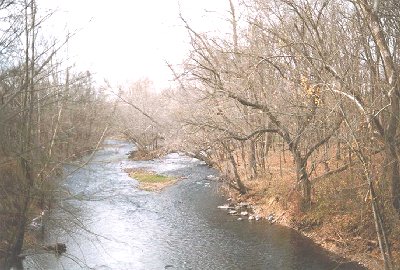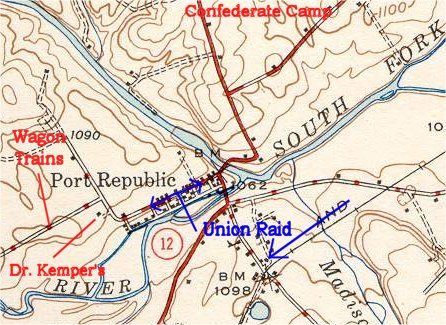
Port Republic - Union Raid Into Town
June 8, 1862
On June 6th, in a clash with Union infantry, Turner Ashby, Jackson's recklessly brave cavalry commander, had been killed. The Confederate cavalry in the Valley had not bothered itself with discipline, and Ashby's death only worsened the situation. Although this lack of discipline would nearly lead to disaster at Port Republic, Jackson understood his basic situation well enough.
While Fremont's Yankee army moved south along the Shenandoah Valley, along the eastern side of the Massanutten Mountain range, Shields' division of McDowell's corps advanced south through the Luray Valley. Jackson encamped his exhausted army near Port Republic, a central location where the North and South Rivers join to form the South Fork of the Shenandoah River. This flooded river separated Fremont from Shields, and prevented them from coordinating their actions. Because of flooding, Fremont had no choice but to advance on Port Republic, the location of the only surviving bridge over the North River. And because of the short distance east to the Blue Ridge, Shields' advance was also channeled to Port Republic. So Jackson had the opportunity to strike them individually. First, however, he would face an unexpected cavalry raid that nearly ended his famed Valley Campaign in disaster.

The South River
While much of his army camped just north of the town of Port Republic beyond the North River, Jackson headquartered on the south side of the river, at Dr. Kemper's house, Madison Hall, on the far end of town. He dispatched Ewell's division to face Fremont, but sent only some undependable cavalry to scout Shields' advance, and he believed him to be miles away. Weary from their forced marches to avoid encirclement, and now content that they had reached safety, Jackson's army's was resting contentedly.
But their rest wouldn't last long. Early on the morning of June 8th, Union cavalry, far in advance of Shields' column, eluded the poorly led Confederate cavalry and entered the town after crossing the South River, despite its flood level. (Indeed, the river had already washed several men to their deaths and was a major obstacle.) Possession or destruction of the bridge over the North River would have isolated most of Jackson's command from its wagon trains, just west of town, the capture or scattering of which would have forced Jackson to abandon the Shenandoah Valley as best he could - with potentially dire consequences for the Confederacy. To the surprise of everyone involved, the Confederates were in grave danger.
|
 |
 |
| Cavalrymen's Turn From Main Street |
 |
| View From Near Moore's Men |
The Battle of Dr. Kemper's Front Lawn
At his headquarters at Dr. Kemper's House, Jackson heard the sounds of firing and rushed through the town, briefly stopped to advise a staff officer against using profanity, barely escaping capture in his flight to cross the North River bridge and join his men. Some of Jackson's staff were briefly captured, but in the confused situation at the end of the raid, would escape. The teamsters beyond the house began to panic, and there appeared to be little to prevent the Yankees from capturing the wagons.
Disaster was averted, however. Cpt. Moore, nearby with twelve men picketing the South River, moved across Dr. Kemper's lawn and positioned his men on a small hill behind the doctor's fence. Soon, Yankee cavalry turned the corner and continued up the road. Moore's men fired at two hundred feet then advanced, repulsing the Yanks. Moore returned to the fence and was joined by one gun of Carrington's Charlottesville battery, a new and untested unit which had been near the wagons.
The cavalry made a second attempt, but were again repulsed.
Two more of Carrington's guns moved behind Dr. Kemper's house to take up a
position to fire all the way down Main Street, along the length of town. Events at the bridge north of town,
however, ended the fighting here at Dr. Kemper's house.

Site of the North River Bridge
This was the location of the covered bridge over the North River. Taken from what was the southern end of the bridge, the photo show the remains of two stone supports in the river. Jackson had fled across the bridge to the other side and alerted his men camped on the hill. As a gun of Yankee horse artillery placed itself at this end of the bridge, Jackson believed it was one of his guns and motioned the men over the river. Union fire, however, made clear his mistake.
Confederate artillery responded, and the infantry prepared to
retake the town. Fulkerson's 37th Va. charged across the bridge directly
toward
the Federal gun. Union gunners aimed for the roof supports, however, and
amazingly no Rebels were hit. With no harm done to the enemy, the Yankees
fled, and the Union gun was taken. The Yankee raiders fled across the
river, and Confederate artillery west of the South Fork harried the retreating
cavalrymen for two miles.
Back to Cross Keys and Port Republic